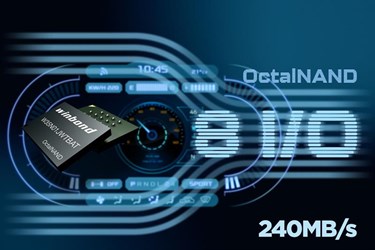Winbond’s OctalNAND Flash interoperates with Synopsys DesignWare AMBA IP

Winbond Electronics has announced the successful interoperability of Synopsys’ DesignWare Synchronous Serial Interface (SSI) IP with the company’s OctalNAND Flash Memory.
The DesignWare SSI IP, offering high transfer rates and low latency in serial flash memories and OctalNAND Flash deliver a complete NAND flash memory solution for automotive, mobile and IoT SoCs, enabling faster adoption of octal non-volatile memories (NVM) with high-speed read bandwidth in densities up to 4Gbit.
Winbond developed OctalNAND Flash because flash suppliers are reaching the limits of NOR technology’s ability to provide high-density NVM cost effectively while still being assembled in industry standard packages. In applications such as Advanced Driver Assistance Systems (ADAS), Cluster (dashboard), and Factory Automation Controllers, system designers have traditionally been using NOR. As the code size routinely exceeds 512Mb, NOR Flash costs much more than the equivalent density NAND.
“By supporting Winbond’s OctalNAND controller with the silicon-proven DesignWare SSI IP, Synopsys provides fast memory access while simplifying the effort of integrating OctalNAND Flash into mobile, consumer, IoT, and automotive SoCs,” explained John Koeter, senior vice president of marketing and strategy for IP at Synopsys. “Using the combination of DesignWare SSI IP and OctalNAND Flash, SoC designers can accelerate their time-to-market for SoCs requiring cost-efficient, high-speed, high-density code storage flash memories.”
“Winbond collaborated with Synopsys to support OctalNAND Flash with DesignWare SSI IP, enabling chipset customers to more easily take advantage of the advanced features available in OctalNAND Flash,” said J.W. Park, Technology Executive of Winbond Flash Memory. “System makers using chipsets that incorporate both OctalNAND Flash and DesignWare SSI IP will be able to choose the most appropriate code storage flash available in the market, including SpiNOR Flash, QspiNAND Flash, or OctalNAND Flash, according to their performance, density, and price point objectives.
As the majority of high density embedded applications use flash for boot then code shadow into DRAM for execution, OctalNAND Flash has read throughput of 240Mbytes/s along with the ability to continuously read from the beginning to near the end of the flash memory space.
While NAND devices can come with bad memory blocks, Winbond’s OctalNAND Flash comes with the block management look-up table feature that enables bad blocks to be mapped away and replaced with good blocks, enabling the host to maintain a contiguous address space and simplifying high speed code shadowing without the host having to skip around bad blocks.
As the OTA (Over-the-Air) update capability becomes a standard feature in embedded system designs, the density usage often doubles. 1Gb and 2Gb for code storage are now common. 4Gb is also being regularly considered.
With OTA, erase and program performance of the flash becomes important. Compared to NOR Flash, OctalNAND Flash is capable of erasing up to 400 times faster and programming up to 50 times faster.
When a large section of the flash needs to be OTA updated, moving from a NOR device to OctalNAND Flash can mean a reduction of Erase/Program time from nearly 10 min to less than 1 min thus greatly improving system availability and user experience.